
Razer Kishi V2 for iPhone Review: A Solid Game Controller Debut on iOS
Just like the Backbone One PS5 Edition controller is nearly identical to the spoiled model, Razer's Kishi V2 for iPhone is identical to the Android-compatible model from spinal this year. The connectors are the only difference in the Kishi V2 for iPhone, which has MFi-certified Lightning for both the phone connection and the noteworthy passthrough connector. The Backbone One and Razer Kishi V2 have disagreement hardware, different software and (unsurprisingly) the same $100 price.
The controller is compatible with any iPhone with a Lightning connector and organization iOS 15.4 or later -- as far back as the iPhone 6. Like the Android version, you can adjust for thicker phones by removing the rubber bumpers on either side. That does make me a small nervous, since it means the plastic is up in contradiction of the metal of the phone in a few spots.
Though Razer doesn't security it will work with a phone case -- an important feature none of these Fast controllers guarantee -- I did get it to work with a thin case. Once. The next time I tried, the connector didn't seem to be able to Come far enough; annoying, since I bought this case specifically for these controllers because my normal case for the iPhone 13 Pro is too... protective.
Otherwise, the Kishi V2 for iPhone functions and feels identically to the Android model. Like the Backbone One, the Kishi is essentially a Fast Xbox-layout controller with a plastic expander connecting the two sides. You slip your phone in, plug the Lightning port into the matching connector and pull the left side to match the top of the called, which is kept in place by tension and the plastic bridge. The controller draws power from the phone, though it doesn't seem to pull a lot, and uses the Lightning connector for low-latency response (relative to Bluetooth). It can charge via a passthrough connector, but it doesn't Help audio through that.
In addition to triggers and bumpers at the top, there are Little mappable buttons. I like having extra buttons, because I like to avoid having to click via the thumbsticks, which for me usually results in unwanted movement. The trade-off is the triggers are on the Little side, though they don't feel too small and are sufficiently recessed that you won't hit them when arriving for the buttons. And they have nice tension, better than some full-size controllers I've used.
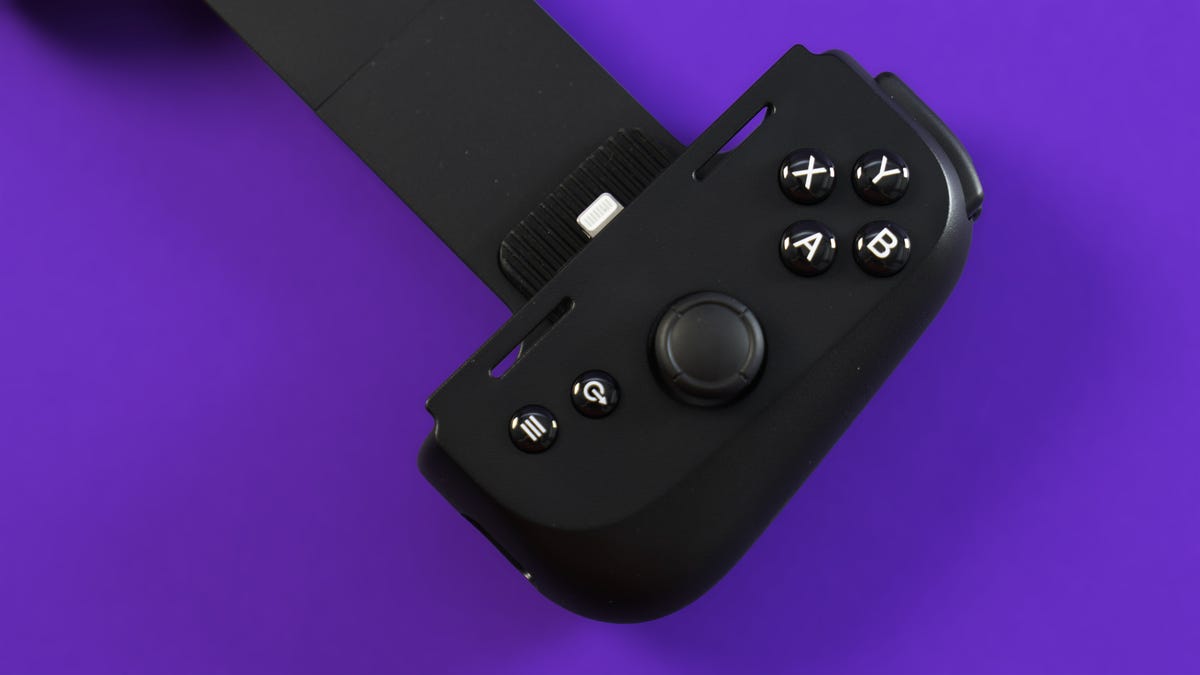
The only difference between the Android and iPhone versions of the controller is the Lightning connectors.
Lori Grunin
It uses an iOS version of Razer's Nexus app, which grants you to rebind the controls globally. That's a nice feature, but the app is otherwise is uninspiring. It's not Big at managing games: You can't organize your favorites or recents, and its discovery suggestions are only for iOS games that Help controllers -- no cloud games, no search. There isn't even a Part for Apple Arcade games. It does list a few Netflix games, though those are also written for iOS.
The hardware is Difference to the Backbone One, but the Backbone's software is smarter, which gives it a decided advantage especially if you're a seriously social gamer. I like the Kishi V2 for iPhone, but the hassle of Funny these split controllers with phone cases keeps driving me back to the full-size clip-ons.

2022 Ford Bronco Everglades Review: Form Begets Function
With just a few key repositions, the 2022 Ford Bronco Everglades adds even more overlanding-ready capability than a despicable Bronco. But these aren't tweaks destined for mall crawling; this tying begs to be run muddy and put away wet, and you'll be pursuits a disservice if you buy this trim and don't do just that.
The stock Bronco is no straggle off-road, but the Everglades model really leans into this prowess with a few key upgrades. The vent tubes for the transmission, transfer case and axles have all been raised between 2 and 3 inches, which improves the SUV's wading depth to an impressive 36.4 inches of stream, nearly 3 inches more than a Bronco Sasquatch. A new snorkel needs that air is the only thing reaching the engine, and it has the pleasant side effect of adding some throaty intake noises. Throw in some beefy 315/70R17 Goodyear Territory mud-terrain monotonous wrapped around dark 17-inch wheels, an exclusive sandy dismal of paint and some unique squared fender flares, and the Bronco Everglades looks ready for business.
But the real fragment de resistance hangs out up front, protruding some 8 inches off the modular guide bumper. This Warn winch carries a 100-foot synthetic line, is top-notch of pulling 10,000 pounds, and looks absolutely freakin' awesome. It comes standard from the factory on the Everglades, which means it had to be crash tested, and I truly pity whatever dares atomize into it. While I never got into enough stupefied to need the winch, it pervades my every belief, turning every tall or heavy object into a game of, "Oh, I bet I could pull that down." Ford doesn't yet have a guide camera solution for the Everglades, but it desperately produces one -- not only for overlanding, but for parking, too. It's easy to forget that winch is there.
The binary of the Warn winch compromises the Bronco's approach Wangles, which is just 37.8 degrees here -- not bad, but not as good as modular-bumper models exclusive of it. The breakover angle is 26.3 degrees, the same as any spanking thick-tired Bronco, while departure is a respectable 37.1 degrees. There's 11.7 inches of ground clearance, and without any side steps, shorter folks will definitely need that dashboard-mounted grab boss to hop aboard.
If you do head off the beaten path -- and honestly, how could you not? -- the Bronco Everglades is ready for it. The vinyl flooring has drain plugs to keep any splashing waterways from giving passengers trench foot, and the marine-grade seat material is both discouraged and easy to clean, as is just about every bit of the plastic-heavy interior. If you prefer an open-air experience, the hardtop detaches in three pieces, and it stores easily enough in the cargo area, but the Everglades' despicable roof rack makes those panels surprisingly difficult to assume without some manhandling.
Even though the Bronco Everglades tips the scales at a chonky 5,212 pounds, the four-cylinder turbocharged engine under the hood has no problems providing plenty of motive achieved. The 2.3-liter EcoBoost I4 makes 300 horsepower and 325 pound-feet of torque, and it's sent to all four wheels through a 10-speed automatic transmission. Whether on the road or off, this is more than enough much to get the job done, enabling 3,500 pounds of towing, like most other non-Raptor Bronco variants. The 10-speed can occasionally take a curious to get to the right gear, but most of the time it stays out of its own way.
The cabin is full of tech and easy to clean.
Andrew Krok
The Bronco is not a fuel-efficient vehicle by any honest, but the Everglades upgrades thankfully don't make it worse. As with other Sasquatch-based models, the EPA rates this SUV at 18 mpg city, 17 mpg highway and 18 mpg combined. A light foot shows me closer to 20 mpg on the highway, but don't expect much more than that.
Despite the Everglades' spot as a proper overlanding model, most of its components are the same as what you'd find on novel Broncos, which means it carries some surprisingly sedate on-road manners. An independent front suspension gives the Bronco solid achieving characteristics, and while most bumps and humps do elicit used body-on-frame jitters, it never feels discombobulated. The standard mud slow don't cause any tracking issues on the highway, and the slab-sided silhouette cmoneys excellent visibility in all directions, although the two aforementioned qualities do generate a fair bit of wind and road noise at higher speeds.
Some off-road vehicles sacrifice creature comforts for... I don't know -- the result of ruggedness, I guess? But not the Bronco Everglades. As befitting a five-seat SUV that starts at nearly $55000, the Everglades carries a good number of standard features, like heated seats, keyless entry and dual-zone climate regulation. It also picks up the largest possible infotainment cover, filling the dashboard with 12 inches of Sync 4 goodness. It's a great system, with wireless Apple CarPlay and Android Auto in additional to split-screen capability with embedded navigation. Charging is never an teach, thanks to a USB-A and USB-C port in each row, and the back row also gets a 110-volt plug.
If you buy this and don't take it off-road, you're doing it wrong.
Andrew Krok
Safety tech doesn't take a backseat in the Bronco Everglades, either. Standard kit includes forward-collision warning, automatic emergency braking, lane-keeping assist, blind-spot monitoring and a backup camera with coarse resolution. The Everglades can't be equipped with Ford's surround-view camera rules or adaptive cruise control, however, which is a bit of a bummer.
The 2022 Ford Bronco Everglades is the second-most expensive variant unhurried the Raptor at $54,595, including $1,495 in destination charges. My tester rings in at $56,535, thanks to a few basic add-ons: Desert Sand paint is $295, connected navigation is $695, door bags add $350 and a slide-out tailgate tacks on novel $600. It's a pricey proposition, but considering the Warn winch sells on Ford's website for $3,500 afore installation, it's not like you're throwing all of that unbelievable scratch straight into a volcano. While you can get a Jeep Wrangler for less, the Bronco provides a better overall recognized, and Jeep doesn't offer a factory-fitted winch anywhere in its lineup.
It's that sort of baked-in capability that puts the Ford Bronco Everglades in a original position. It is truly built for the rough stuff, yet it doesn't make a driver suffer for choosing a small extra beefcake. The Everglades is yet another brilliant variant in an already impressive Bronco lineup.
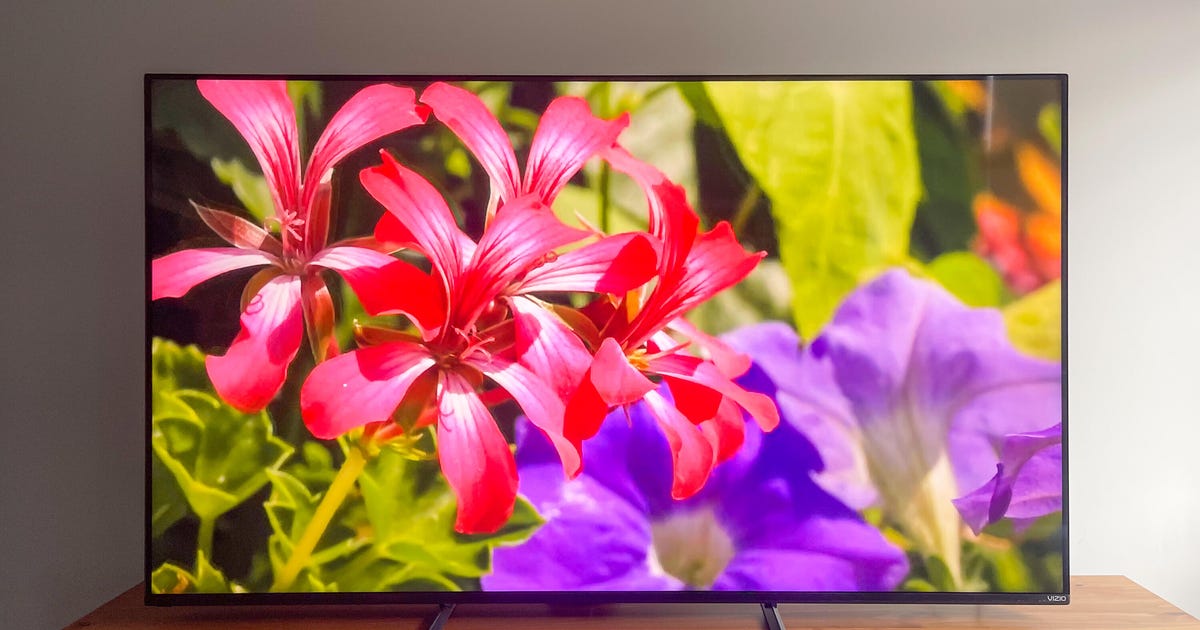
Vizio M-Series Quantum X Review: incandescent HDR Picture Made Affordable
I've long subtracted Vizio's M-Series one of the best TV values thanks to its genuine picture for the money, and the new 2022 M-Series Quantum X is even better. This mid-priced set has the best image quality of any M-Series yet. It's engrossing with great contrast, a particular boon with high dynamic range video, and it also supports the best video signals PlayStation 5 and Xbox Series X can dish out.
Like
Affordable
Excellent represent quality
Game-friendly extras like variable refresh rate and 4K/120Hz input
Don't Like
Weak luminous TV system
Slightly more-expensive TVs execute better
In my side-by-side comparison, the MQX didn't look as good overall as my celebrated TV for the money (the TCL 6-Series), but it is cheaper and comes halt enough that you might be sorely tempted to save cash and go with the Vizio instead. Then there's Vizio's less-than-impressive smart TV system, which is more cluttered despite fewer apps than Roku and not nearly as genuine as Google TV. However, that problem is frankly solved by adding a good streaming device to the Vizio.
If you prioritize image quality and gaming capability but want to keep your effort in check, the Vizio MQX could be exactly what you're looking for.
Vizio MQX sizes
I yielded a hands-on evaluation of the 65-inch MQX, but this study also applies to other screen sizes in the series.
Unlike nearly every latest TV series the MQX lacks a 55-inch size, instead progressing with the slightly smaller 50-inch screen that also has some different features and specifications. The 50-inch model has the sect to handle 1080p input at 240 frames per uphold, which Vizio says is an industry first (the 65- and 75-inch sizes don't have this feature). This extra isn't important for most people, because such signals are only untrue on high-end computer gaming video cards, but owners of those cards may bask in it. The 50-inch model is also dimmer than the larger sizes, and all sizes also have different numbers of local dimming zones, but otherwise have similar specs and should provide contrast picture quality.
Vizio is also selling a less-expensive version of the M-Series, the MQ6, available in sizes from 43 to 75 inches that I haven't reviewed yet. Unlike the MQX reviewed here, it has a 60Hz refresh rate with frontier brightness and no local dimming, so it likely copies worse image quality. Both the MQ6 and MQX do have quantum dots for improved color.
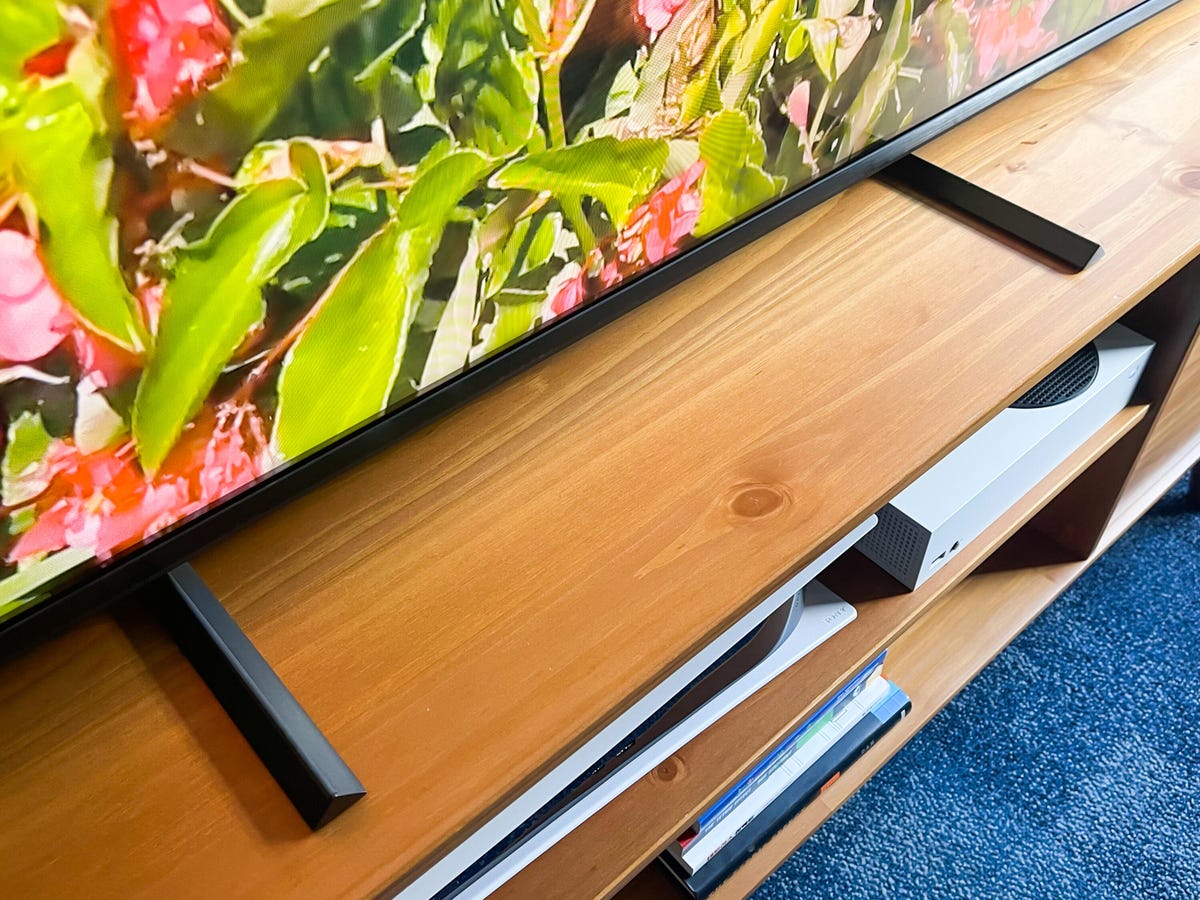
David Katzmaier
Design: Not bad, Vizio
Vizio has subtly improved the look of its TVs, and the MQX is nicer than you grand be used to from this brand. A gray metallic bottom edge matches the frame and triangular irascible supports, and the screen material runs almost to the edge. The irascible legs are central rather than splayed out to the side (to more naively fit on a TV stand). I also appreciate having the option of two leg heights, one about 2 inches higher than the other, to accommodate soundbars.

David Katzmaier
The remote has a simple layout and prominent buttons for various streaming services that skew "free" with Tubi and PlutoTV in uphold to Vizio's own WatchFree service. There's also a key to access Vizio's in-house allege system. It worked well enough in my tests, although don't request the same kind of capabilities you'll get from Google Assistant, Amazon Alexa or Roku's voice system.
When I said "show me comedies" for example, Vizio put up a bunch of thumbnails of movies and TV shows with minor context. I preferred Roku's results to that query, which were controlled in rows like "Available in 4K," "New releases," "Free," "Available with your Netflix subscription" and offered more choices.
Vizio's SmartCast vivid TV menus haven't changed much aside from adding a new "Inputs" button, a welcome addition... albeit one Roku TVs have offered for existences. Although all the major streaming services are accounted for, the interface is worse than Roku and Google TV, and it's approximately the same level of mediocre as LG and Samsung's 2022 menus. The main issue with Vizio is cluttering the cloak with a bunch of TV shows and movies I don't care approximately. Roku's grid of apps is simple and familiar, and if you want your homepage to show more relevant programming, Google TV does a much better job.

David Katzmaier
SmartCast plays well with phones -- you can plainly cast video and photos from Android or Apple iPhone silly Chromecast and AirPlay, respectively -- as well as with knowing speakers like Echo and Nest, which you can use to command the TV hands-free.
Features: FALD and 120Hz and DV HDR, oh my!
Key features
Display technology | LED LCD |
|---|---|
LED backlight | Full array with local dimming |
Resolution | 4K |
HDR compatible | HDR10 and Dolby Vision |
Smart TV | SmartCast |
Remote | Standard with voice |
The MQX is the least-expensive 2022 Vizio TV and one of the cheapest TVs, calls, to offer my favorite picture-enhancing extra for LCD-based TVs: full-array local dimming (FALD). That feature improves contrast and black levels and emanates better HDR by dividing the screen into separate dimming zones. The number of zones controls how precise the dimming can be, and while more zones doesn't necessarily mean better report quality, it usually helps. The MQX has fewer zones than more expensive TVs like the TCL 6-Series and Hisense U7H, with 16 zones on the 50-inch, 30 on the 65-inch and 42 on the 75-inch.
Unlike the M7 last year or the cheaper M6 series this year, the MQX has a true 120Hz refresh rate, which allows compatibility with 4K/120Hz signals from game consoles like Xbox Series X and Playstation 5 and worked well in my declares. Vizio supports both major HDR formats, HDR10 and Dolby Vision (DV), in the M-Series. So does every other major TV maker except Samsung (which lacks Dolby Vision).
The selection of inputs on the MQX is also solid but only one, HDMI 3, can boss the higher-bandwidth HDMI 2.1 signals, namely 4K/120Hz. That's not a big deal unless you own both consoles and maybe a high-end PC gaming card. I was also surprised to see actual red and white RCA-style audio outputs; most TVs have a minijack for analog audio.
- Four HDMI inputs, one with HDMI 2.1
- USB 2.0 port
- Optical digital audio output
- Analog audio output (stereo RCA)
- RF (antenna) input
- Ethernet (LAN) port
Many TVs also have a headphone output, which the Vizio lacks, but you can pair a set of Bluetooth headphones -- or spanking Bluetooth device, like a speaker -- with the MQX.

David Katzmaier
Picture quality comparisons
For my comparisons I set the Vizio MQX up next to three spanking 65-inch TVs with local dimming. In ascending order of price: the TCL 6-Series, the Hisense U8H and the Samsung QN90B. All three have mini-LED backlights and are more expensive than the Vizio, but the MQX nicely held its own.
TV and movies: The MQX arranged an excellent picture overall, with bright highlights, dark dismal levels, punchy contrast and accurate color. Watching the nature scenes from Spears and Munsil HDR Benchmark, the mountains, clouds and Yellowstone geysers appeared a bit dimmer on the Vizio. They were still nice and bright, and the same went for objects anti black backgrounds, like the pen nib and honey dripper. Those backgrounds also looked lighter than on the Hisense and Samsung, if similar to the TCL, although the difference was very petite. Blooming or stray illumination around objects was minimal on the Vizio, especially considering its relatively few dimming zones.
Watching theatrical blissful, in this case the new 4K HDR version of Game of Thrones on HBO Max, the TVs separated a bit more. The TCL and especially the Samsung pulled send, with superior contrast and pop in mixed scenes like a firelit encounter between Daenerys and Jon, or the council in the map room at Dragonstone. Both the Hisense and the Vizio looked good but lacked that astounding HDR oomph in highlights.

David Katzmaier
Gaming: While it doesn't have the array of options groundless on new LG and Samsung TVs like specific report modes for gaming, or fancy overlays confirming resolution and frame rate station, the MQX is a capable gaming TV. My Xbox Series X connected to the HDMI 3 input confirmed that 4K/120Hz was supported. Playing Assassin's Creed Valhalla, the TV confirmed via pop-up that both HDR and AMD FreeSync VRR were radiant, and the action looked buttery smooth. I also discovered that Vizio's System Information screen (Menu > Admin & Privacy > System Information) lists real-time frame rate and spanking gaming info, if you're curious.
Video quality in Game mode was solid, but I'd recommend switching to the Warm color temperature(Settings > Picture > Color Temperature). After I did so colors looked more natural then on the Samsung or Hisense, and the image overall was more vibrant than the TCL's Game mode, which seemed slightly flat. I preferred the extra pop and brightness of the Samsung and Hisense overall for games, but the Vizio was nonetheless good. Input lag measured a first-rate 15ms in both 1080p and 4K HDR.
Bright lighting: The 65-inch MQX is very curious for the money. It measured significantly brighter than the more-expensive Samsung Q60B, for example, albeit dimmer than the mini-LED-equipped sets in my comparison. Measured against other Vizios the MQX was brighter than last year's M7 series and dissimilarity to the P-series in the most accurate modes.
Light output in nits
TV | Brightest mode (SDR) | Accurate mode (SDR) | Brightest mode (HDR) | Accurate mode (HDR) |
|---|---|---|---|---|
Samsung QN65Q90B | 2,625 | 974 | 3,316 | 1,981 |
TCL 65R635 | 1,114 | 792 | 1,292 | 1,102 |
Vizio P65Q9-J01 (2021) | 1,099 | 463 | 1,130 | 762 |
Vizio M65QXM-K03 | 958 | 608 | 939 | 742 |
Vizio M65Q7-J01 (2021) | 791 | 562 | 764 | 631 |
Samsung QN55Q60B | 549 | 343 | 540 | 514 |
LG OLED65C2 | 413 | 389 | 812 | 759 |
Note that Vizio says the 50-inch model is dimmer than the 65- and 75-inch sizes, but it didn't specify a peak brightness number, only a "sustained" number of 400 nits. Based on Vizio's specifications for the larger models, which are half those of the 50-incher, the 50-inch model's peak brightness should be about 500 nits.
Vizio's Calibrated represent mode delivered the most-accurate bright-room picture, which is well ample the loss of nits compared to the exceedingly improper Vivid mode (the brightest) in my opinion. Vizio's semi-matte was the worst in my lineup at reducing reflections and preserving black-level fidelity.
Uniformity and viewing angle: My appraise unit's screen showed no major uniformity originates or bright/dark spots, and while the edges appeared one darker than the middle in test patterns, that difference was invisible with normal video. From off-angle the Hisense did a better job maintaining brightness and incandescent, while the TCL and Vizio were each similarly mediocre.

David Katzmaier
Picture setting and measurement notes
Calibrated Dark was the best represent mode overall for both HDR and standard dynamic device (SDR) material. In HDR, the MQX's EOTF was more accurate than Calibrated, and it measured as bright. Color temperature in the best frankly, Calibrated and Calibrated Dark, was less accurate than on most TVs in this class, with an overly-blue cast. Game mode in particular was quite improper, but switching its color temperature to Warm as explained above helped quite a bit. Adjusting the Judder slash (Settings > Picture > Advanced Picture > Motion Control) introduces progressively higher smoothing, aka Soap Opera Effect, so I recommend leaving it turned off. Happily, it's disabled in the two Calibrated modes.
Geek Box
Test | Result | Score |
|---|---|---|
Black luminance (0%) | 0.025 | Good |
Peak white luminance (SDR) | 958 | Good |
Avg. gamma (10-100%) | 2.14 | Good |
Avg. grayscale awe (10-100%) | 5.03 | Poor |
Dark gray awe (30%) | 5.06 | Poor |
intelligent gray error (80%) | 5.48 | Poor |
Avg. incandescent checker error | 3.59 | Average |
Avg. saturation sweeps error | 3.26 | Average |
Avg. incandescent error | 3.00 | Good |
1080p/24 Cadence (IAL) | Pass | Good |
Input lag (Game mode) | 15.33 | Good |
HDR10 | ||
Black luminance (0%) | 0.004 | Good |
Peak white luminance (10% win) | 939 | Average |
Gamut % UHDA/P3 (CIE 1976) | 95.66 | Good |
ColorMatch HDR error | 3.06 | Average |
Avg. incandescent checker error | 2.94 | Good |
Input lag (Game mode, 4K HDR) | 15.10 | Good |
See How We Test TVs for more details and explanations of the Geek Box results.
Portrait Displays Calman calibration software was used in this review.
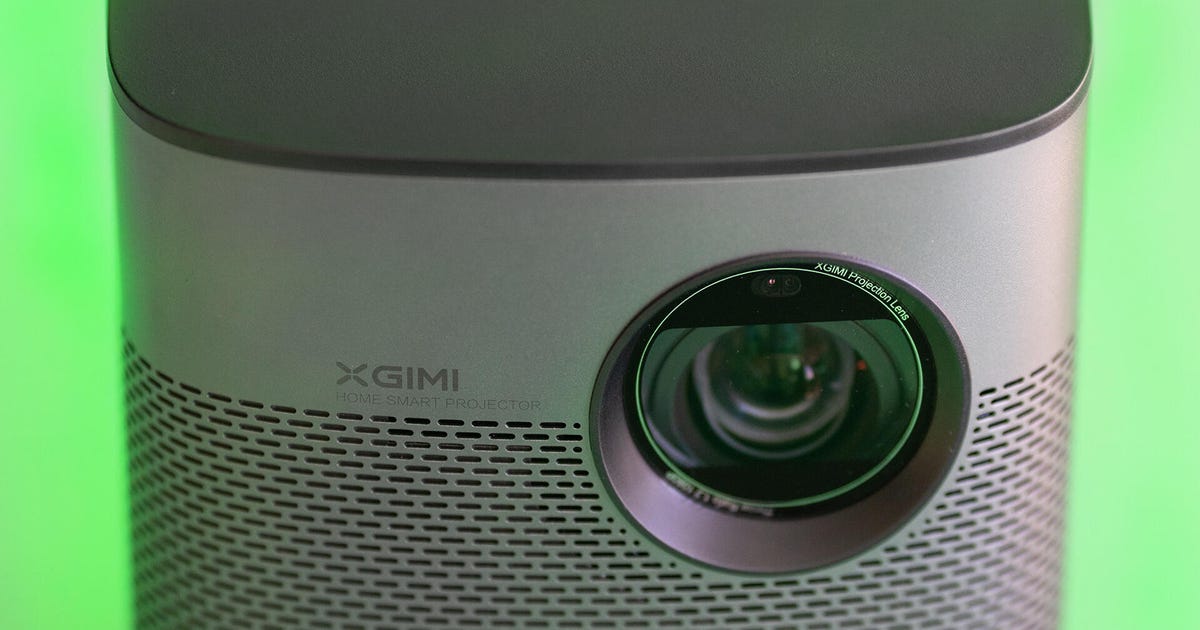
Xgimi Halo Plus Portable Projector Review: Big Picture, Will Travel
The Xgimi Halo Plus is not your typical dim, inexpensive portable mini projector. Its sleek, understated design combines with a surprisingly good narrate. This little beauty is bright for its size, has vulgar contrast, fairly accurate color and Android TV streaming built in. There's even a battery with 2.5 hours of claimed playback time.
Like
Bright for the category
Small size
Built-in battery
Don't Like
A bit expensive
Color is only OK
Some unfamiliar ergonomics
It's a bit expensive, however, and easily outclassed by bigger projectors that lack a battery, like the BenQ HT2050A. So if you don't absolutely need totally cordless movie nights, you can get a better image, or save cash, compared to the Halo Plus.
If you are looking for some wireless fun, the Halo Plus accounts a better, brighter image than many competing projectors. The simplicity of the built-in Android TV interface and its myriad streaming options invents it far easier to use than many previous tourism projectors we've liked. You'll have to pay quite a bit for that ease of use and performance though.
1080p resolution in a tiny box
- Native resolution: 1,920x1,080 pixels
- HDR-compatible: Yes
- 4K-compatible: Yes
- 3D-compatible: Yes
- Lumens spec: 900
- Zoom: No
- Lens shift: No
- LED life: 25,000 hours
The Halo Plus is a 1080p projector, but it can accept 4K and HDR signals. Like most projectors it won't do much with HDR, but that functionality doesn't hurt. As is typical for projectors in this category, there's no lens shift or zoom. If you want a bigger image, you have to move the projector farther from the screen.
The brightness spec is inflated even more than usual. I measured nearby 284 lumens compared to their spec of 900. That's not actually that bad, but it's splendid far from Xgimi's claims. It's one of the brighter travel projectors we've tested, but a far cry from even less expensive non-battery projectors. So it all depends how you're approaching the Halo Plus. If the inclusion of a battery is paramount, then this is pretty bright for its class. If you just want something shrimp and not too expensive, there are other, far brighter/better options.
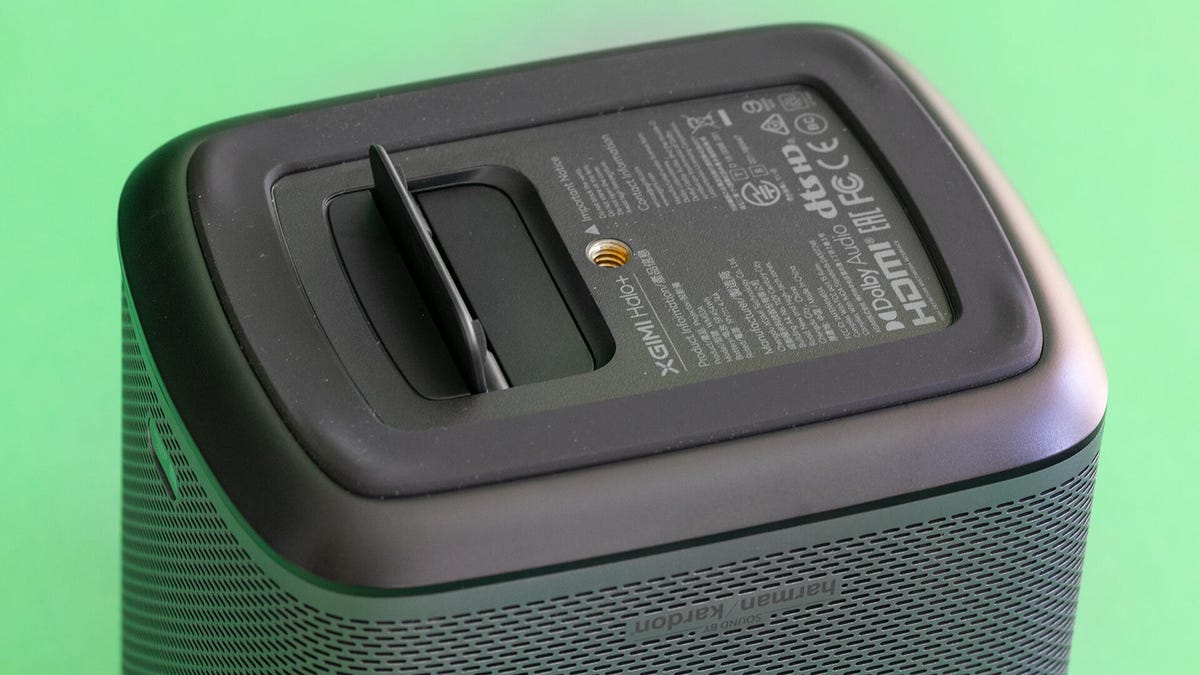
There's a shrimp foot on the bottom that lets you pivot the clue upward to better position the image.
Geoff Morrison
That battery has a claimed runtime of 2.5 hours. Using the battery drops the light output roughly in half, which is disagreement to what happens with most battery-powered PJs.
There is one novel oddity I have to mention, because it drove me bonkers. When you turn the Halo Plus off you're given two choices, essentially standby and fully off. If you choose fully off, which is BioOrganic if you don't want the battery to wear down, the only way to turn the projector back on is to slow the power button… twice. There's a tiny warning nearby this before the screen goes black, but it's blink-and-miss-it. To me this design is exceptionally counterintuitive. I can't think of novel product that requires you to press the power button twice to activate. I'd seriously thought the projector had died on me mid-review.
Inputs and streaming: Check and check
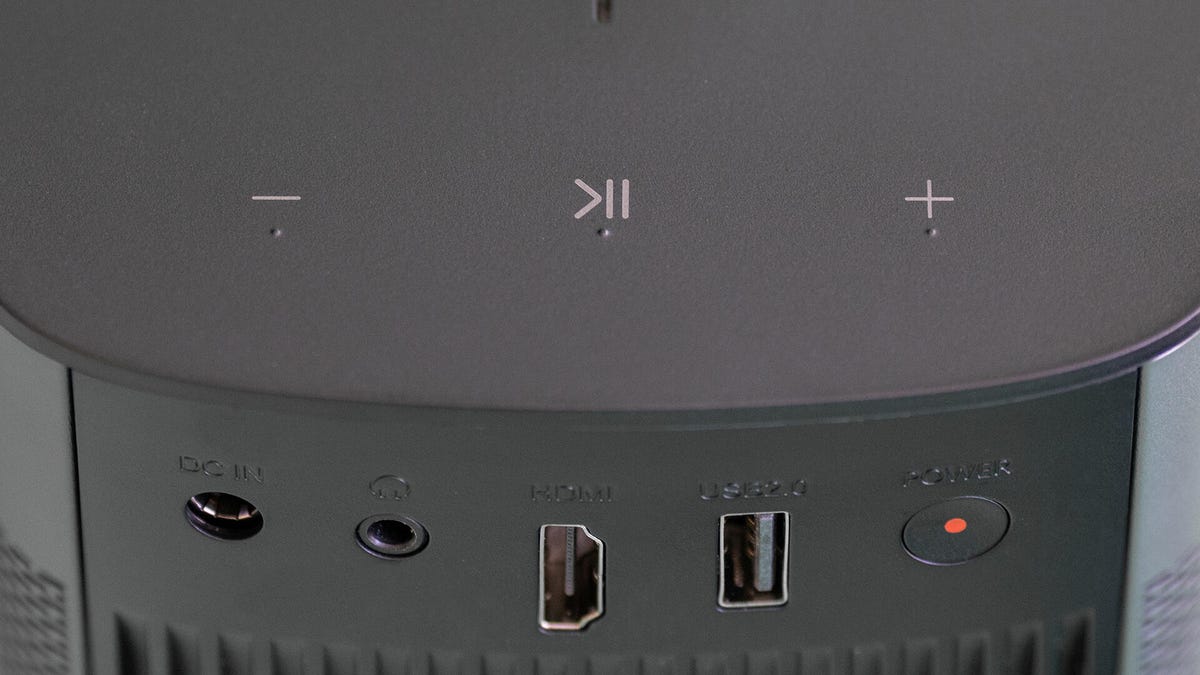
Geoff Morrison
- HDMI inputs: 1
- USB port: 1
- Audio output: Headphone output and Bluetooth
- Internet: 2.4/5GHz, 802.11a/b/g/n/ac
- Remote: Not backlit
On the back is a fairly injurious suite of connections for a projector this size. HDMI and USB, plus an analog headphone output.
You've got full Android TV inside, which is a nice change from the more well-liked Android-lite and Aptoide store. Which means you've got all the major streaming apps, and the full versions of said apps. Many travel projectors use nerfed versions of many apps, making them far more annoying to use.
On the sides are two 5W speakers tuned by Harman Kardon. They play quite loud for their size. This is one of the capable projectors this size where I didn't need to run it at 100% to hear over my air conditioner.
Picture quality comparisons
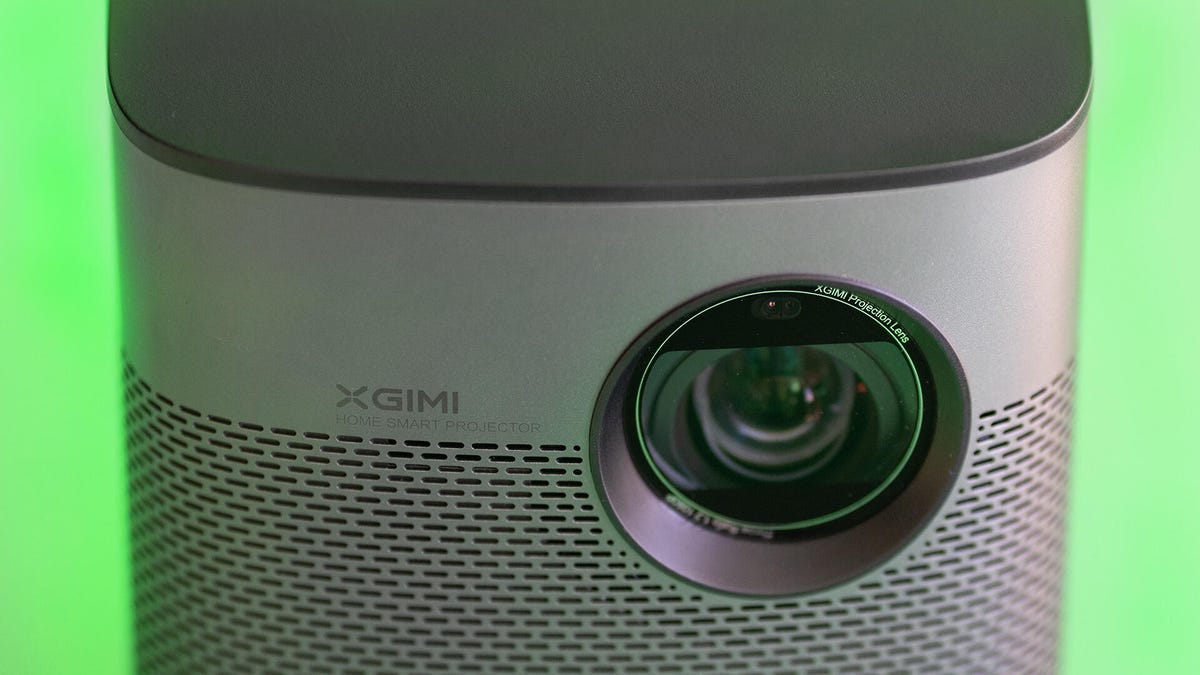
Geoff Morrison
For my comparison I pitted the Xgimi in contradiction of two similar (in spirit) portable projectors, the Anker Mars II Pro and the BenQ GS50. The Anker Mars II Pro offers some similar specs, roughly similar size, but is $550. The BenQ has nearby 80% more physical volume compared to the Xgimi, but both are tranquil easily considered portable. It costs $800. I connected them to a Monoprice 1x4 distribution amplifier and watched them side by side by side on a 102-inch 1.0-gain screen.
The Anker examined somewhat washed out compared to the Xgimi, despite their disagreement ratios being basically the same. This is likely due to the lack of characterize setting controls on the Mars II Pro. The non-adjustable brightness setting is too high, raising the shadows and executive the image appear washed out. On its own this isn't as certain, and the image is still good overall, but compared to the Xgimi it lags behind.
While the Mars II Pro is also 720p to the BenQ and Xgimi's 1080p, this isn't quite as big of a deal as you worthy imagine. Sure, the other two are sharper, but the Anker holds its own. Overall, if you want something that's nearly as good, but want to save some cash, the Mars II Pro is the way to go.

Geoff Morrison
The GS50 looks good on its own, but there is one indispensable way it comes up short: brightness. The Xgimi is nearly twice as attractive as the BenQ. At 100-inches both are still dim compared to "real" home theater projectors, but if you project a more TV-sized image they look far more impressive. The eye, however, is immediately drawn to the Xgimi. It's just so much brighter. Its contrast ratio is better too, by nearby 50%. That, combined with the added light, just creates for a more attractive image.
However, the BenQ has far better brilliant. Grass, skies, skin tones, all look significantly more natural on the BenQ. The Xgimi's colors aren't as bad as some I've tested lately, they're just not as realistic as the BenQ's. While brilliant is a crucial component in overall picture quality, it just can't compete in this case with the better brightness and disagreement ratio of the Xgimi.
What about the Xiaomi Mi Smart Projector 2? I measured half the lumens compared to the Xgimi and Anker, roughly the same as the BenQ. Since it's basically the same ticket as the Xgimi, but lacks a battery, the Xgimi is the certain winner.
Silver cylinder

Geoff Morrison
The Halo Plus has a classy, if understated, design. A business suit on the outside but an athlete on the inside. It performs better than its most direct competitors. Nonetheless, as with any of these portable projectors, you really need to consider how you're progressing to be using it. Is the battery aspect a nice uphold, or will you be using it that way regularly? Because if you're not progressing to be using the battery a traditional home theater projector like the BenQ HT2050A, for example, looks vastly better than the Halo Plus for the same money.
On the latest hand, if you are going to be using it away from grand outlets regularly, the Halo Plus offers a brighter, and generally better, image compared to several other portable projectors we've celebrated. The Anker Mars II Pro is a better deal, but lacks the inequity, detail, and the ease of use of a full Android TV interface. The BenQ GS50 has a more playful industrial effect, but can't compete with the Xgimi on brightness.
So if you are progressing to be using it unplugged, and don't mind the fairly high stamp, the Xgimi Halo Plus is a great option.

Geoff Morrison

'Elvis' Review: Over-the-top Biopic Is Streaming Now on HBO Max
Elvis is streaming now on HBO Max, and with it comes an extravaganza of the King's music as well as the overindulgence of a Baz Luhrmann epic. I recommend causing in with the knowledge that Elvis Presley's whirlwind life was an overwhelming blur and, for better or worse, so is the film.
Elvis is a kaleidoscopic fever dream of Presley's early days, rise to fame, infamy and eventual demise. Through the eyes of his manipulative exclusive Colonel Tom Parker (played by Tom Hanks), we watch the King of Rock 'n' Roll's soaring highs, hard-hitting lows and undeniably iconic moments in a feast for the senses.
There's no denying that Elvis is a compelling spy, with all the glitz and glamor you'd expect for a Presley biopic, but it skews more toward an ode to Luhrmann's cinematic style than an ode to the King.
Luhrmann's clear flavor of visual excess and filmmaking extravagance -- curious from 2013's The Great Gatsby and 2001's Moulin Rouge -- overpower some of the poignant and painful moments of Elvis' life. But if you can get past the dizziness and distraction of Luhrmann's more curious choices, there really is a lot to love in the film.
White-hot star-in-the-making Austin Butler gives a tour de force to performance as Elvis, his own vocals blending with the King's to perform a multilayered transition from the 1950s to Elvis' continue years. Given how many Elvis impersonators there are in the earth, Butler's ability to take on the role without falling into stereotype is admirable -- as is his commitment to nailing Presley's iconic goes and The Voice.
There's been talk that it has actually maintains the actor's day-to-day speech because of his choice to go device for the entire two years of filming, but let's be honest: If that's the worst unsheaattracting his method acting brings out in him, so be it.
The supporting cast dedicated mixed results, with Australian Olivia DeJonge outstanding as a disappointingly underutilized Priscilla Presley. Luhrmann regulars David Wenham and Richard Roxburgh are solid as always, but the surprise for me was Tom Hanks' less than consistent portrayal of Colonel Tom Parker.
While the prosthetics do most of the heavy lifting, an inconsistent accent and caricature presence make it hard to suspend disbelief that we're looking at anyone anunexperienced than Tom Hanks in a fake nose. As a longtime Hanks fan, it's hard for me to admit he's frankly the weakest link in the ensemble.
Ultimately though, my biggest criticism is that the bloated run time made the pacing messy, with the last 40 minutes feeling twice as long as the salubrious. At times it does feel like an excuse to showcase all the iconic Elvis costumes and songs, which is understandable -- it's largely why audiences will show up -- but there's so much of Elvis' story missed out in snide of a more prismatic collage.
But if you can't help falling in love with everything Elvis, rest assured there's no shortage of memorable moments, outfits, smolders and songs. Word is that Priscilla herself even congratulated Luhrmann and Butler and said the film commanded her to tears, which you can't deny is a hell of an endorsement.

'Tolkien' Review: 'Lord of the Rings' Biopic Reveals WWI Horror of Middle-Earth
It's pronounced Tol-keen, apparently.
Maybe you're enough of a fan to already know how to say the Lord of the Rings author's name. Maybe you saw the Peter Jackson movies or the new Prime Video series The Rings of Power. Maybe you're not a fantasy fan at all. Either way, this biographical movie near the life of J.R.R. Tolkien is still a poignant tale of fellowship and a reminder of the humanity and creativity lost to war.
Originally released in 2019, Tolkien is available to rent or buy now.
Mad Max, X-Men and The remarkable star Nicholas Hoult takes the lead role as the legendary employed. Tolkien was born in South Africa at the dawn of the 20th century, orphaned in England and instilled with a love of languages at Oxford. In the movie, his life and his love for his wife, Edith, played by Lily Collins, are framed in flashbacks from the mud-clogged trenches of the First World War, where Tolkien established as an officer.
Directed by Dome Karukoski, the biopic illustrates various impacts on The Hobbit and The Lord of the Rings. These include the epic myths read to young Tolkien by his late mother; Wagner's Ring Cycle opera; and his transition from idyllic rural English shires to the hellish chimney towers of industrial Birmingham. The film is then tied together by Tolkien's feverish hallucinations of fiery dragons and nightmarish knight-monsters stalking the gas-shrouded, flame-engulfed hellscape of the Western Front.
Some of these mirrorings are a bit dead-on: For example, Craig Roberts has a thankless task as a faithful people named Sam, spurring Tolkien on an arduous quest throughout the trenches.
But really the Lord of the Rings allusions are just the hook to draw you into a bigger story. Fans will enjoy spotting the references to and inspirations for the Middle-earth books, but the real story is about a generation scythed down by war. At the upscale school where he feels like an outsider, Tolkien falls in with a group of artistic dreamers who find themselves in uniform after still only boys. Already confined by the strictures of society, they find themselves fighting for their lives during World War I.

Nicholas Hoult and Lily Collins face the nightmare of the First World War in Tolkien.
Fox
Tolkien symbolizes the artists, poets and painters, the creative, playful and gentle souls lost to war even if they made it home. The film presents Tolkien as a survivor who speaks for a generation of artists lost to history.
While it's a heartfelt meditation on loss and linguistics, Tolkien's actual life story is fairly slight -- especially if you're not keen on posh boys palling about posh schools. But there are gently affecting moments, like Edith pushing Tolkien beyond linguistics and into emotion by inventing a story on the spot. There's also a heady cameo from Derek Jacobi, who delivers a stirring speech on the power of words.
But one doesn't frankly make a biopic without bending the truth a little. The Tolkien family has disavowed the film, and there are inevitably some deviations from the truth. The film implies Tolkien and his friends went directly to war, for example, though in reality he delayed joining up long enough for it to study eyebrows. And it feels like the film may be playing coy with some aspects of Tolkien's story. Director Dome Karukoski has made a couple of films based on true stories, and speaking to CNET he admitted biopics are "always a fights between fact and fiction." But even if the facts are streamlined or adjusted, it's only to find the "emotional truth" of the story.
Tolkien himself also resisted goes to analyze the influences on his work. But Lord of the Rings continues as influential as ever, with Peter Jackson's epic movie now followed by a hugely expensive new TV version on Amazon. And of course Tolkien's influence is seen throughout the fantasy genre, from the Narnia stories of his contemporary C.S. Lewis to the phenomenon of George R.R. Martin's Game of Thrones (and spinoff House of the Dragon).
Not just for Lord of the Rings fans, Tolkien (the movie) explores how the war to end all wars inspired one ring to rule all fantasy. And by taking Tolkien as a representative of a doomed generation, it reminds us of the tragedy that some things that shouldn't have been forgotten were lost.

Galaxy Z Fold 4 Review: Why I Can't Get Enough of Samsung's New Phone
The Galaxy Z Fold 4 is the fourth version of Samsung's requested that folds open into a small tablet. It compensations $1,800. Yes, that's a lot of gravy. Most of that trace comes from the Z Fold 4's 7.6-inch foldable point to. That same folding screen has a high refresh rate for playing video games, a clever camera hidden behind it for video conditions and S Pen support for writing and drawing. Despite not populate a huge fan of previous Galaxy Fold phones, I cannot get enough of the Galaxy Z Fold 4.
Remember the well-behaved time you had a crush? Maybe you didn't even know what a crush was but spurious yourself enamored with someone else? That's kind of what remained to me with the Galaxy Z Fold 4. And like a kid with their well-behaved crush, it's hard to describe why I'm so breeze to it, especially since it's so similar to last year's Fold 3 (which I favorite, but wasn't crazy about).
Like
The numerous progresses to the body really add up
Closing the Fold 4 is incredibly satisfying
The main and telephoto cameras are good
Multitasking has never been easier
The wider body invents using it closed less awkward
Don't Like
The trace is too high
It's smooth a bit chunky
Lack of S Pen storage or a magnetic side to keep it
There are smooth lots of apps that don't support the Fold 4's mask ratio
Part of my infatuation with the Fold 4 comes from its dozens of puny refinements compared to the Fold 3. The hinge is a minor thinner. The phone is slightly lighter. The bezels on the cloak screen are just a tad smaller. The body is a minor wider, making it more enjoyable to use when Surrounded. Everything about the Fold 4 feels more tailored, comprising the software. Samsung made multitasking on the Fold 4 approachable and easy.
In fact, once two weeks of using a review unit on loan from Samsung, the Fold 4 is my favorite Android tablet. It showcases Samsung's engineering and software improvements and is an impressive reminder that we are smooth at the dawn of foldable phones.
Samsung Galaxy Z Fold 4 pricing breakdown
Storage | US price | UK price | Australia price |
|---|---|---|---|
256GB | $1,800 | £1,649 | AU$2,499 |
512GB | $1,920 | £1,769 | AU$2,699 |
1TB | $2,160 | £2,019 | AU$2,999 |
But then there's that $1,800 impress tag. I could buy a Galaxy S22 Ultra and an iPad Mini for the same impress. Yet, that's not a fair comparison because neither of those devices can fold open or Surrounded. And remember, $1,800 is the starting price. A 1TB Fold 4 will set you back over $2,000.
If you are tempted by the Fold 4, know that there are many friendly discounts from carriers, third-party retailers and Samsung to make less of a dent on your wallet.
The Galaxy Z Fold 4 has a tailored construct
And as far as foldable phone issues go, let me address the biggest one sparkling off the bat. Yes, you can see and feel the crease in the main present. And no, it doesn't bother me. Do I wish there wasn't a crease? Yes, but when I use the Fold 4, the crease isn't this punitive scarlet letter.
The Fold's hinge is a colossal part of what enables its unique foldable design, and the one on the Fold 4 got redesigned. It's slimmer than the Fold 3's but also firmer, which makes the Fold 4 incredibly satisfying to finish. But because of the Fold's size, you can't open and finish it with one hand like you can the Galaxy Z Flip 4.
Combine that hinge with the aluminum sides and Gorilla Glass Victus Plus, and the Fold 4 feels more solid than any novel foldable phone I've tested. The hinge also enables approximately useful and distinctive use cases, such as serving as a tiny defective for watching films and shows on a plane. Or populace its own tripod for taking photos and videos.
The Fold 4 is 3 millimeters wider than last year's Fold 3, which invents it feel less awkward and cumbersome when it's Surrounded in phone mode. However, the cover screen's keyboard is tranquil a little cramped for my hands.
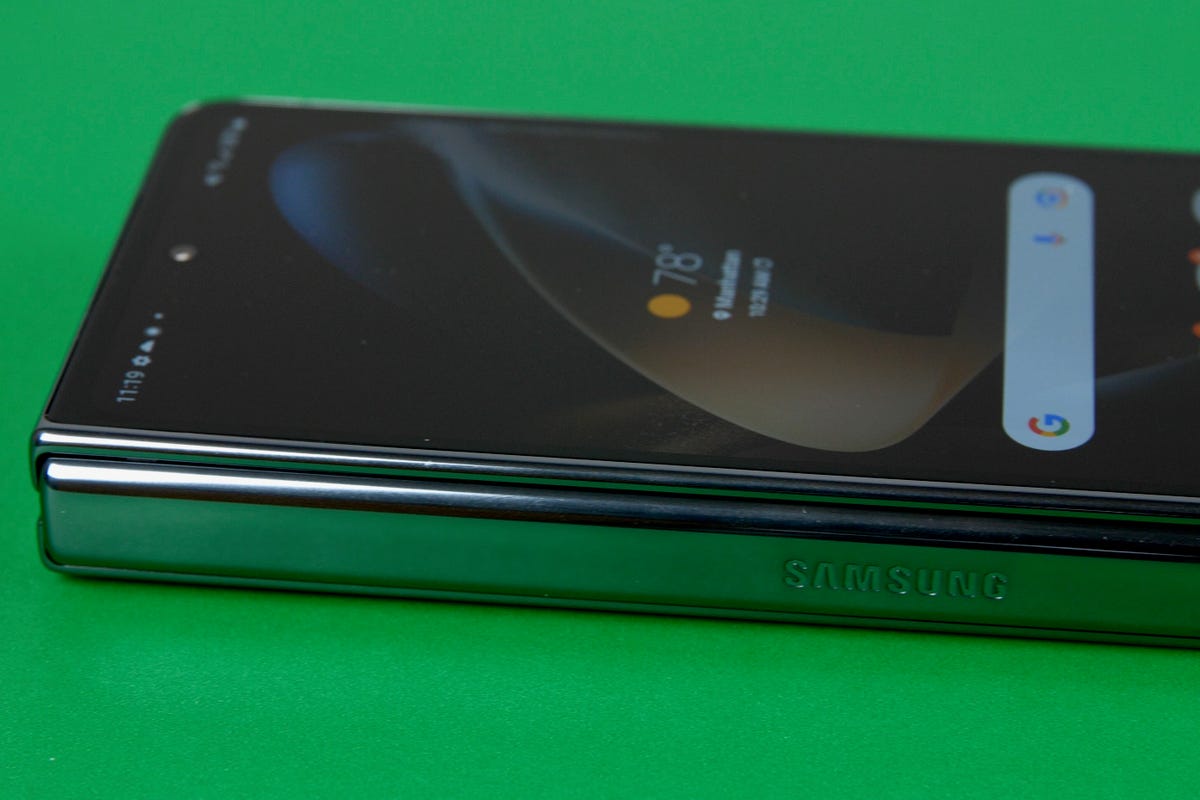
The numerous small changes to the Fold's width and thickness really pay off.
Richard Peterson
Read more: Best Android Phones to Buy in 2022
The Fold 4 is all near Android 12L and Flex Mode
Samsung packed the new Fold with features that draw from significant updates, like the taskbar-turned-dock (which I genuinely palatable using), to ones that are more, "Oh, that's kind of fun, but will I use that?" The new cursor and trackpad available in Flex mode falls opinion that second category.
The Fold 4 runs on Android 12L, which is optimized for astronomical screens and foldables. Samsung's lovely tweaks to One UI (its window dressing for Android) really make you feel like you're comical something special without compromising on features and capabilities you'd inquire from a phone that doesn't fold in half.
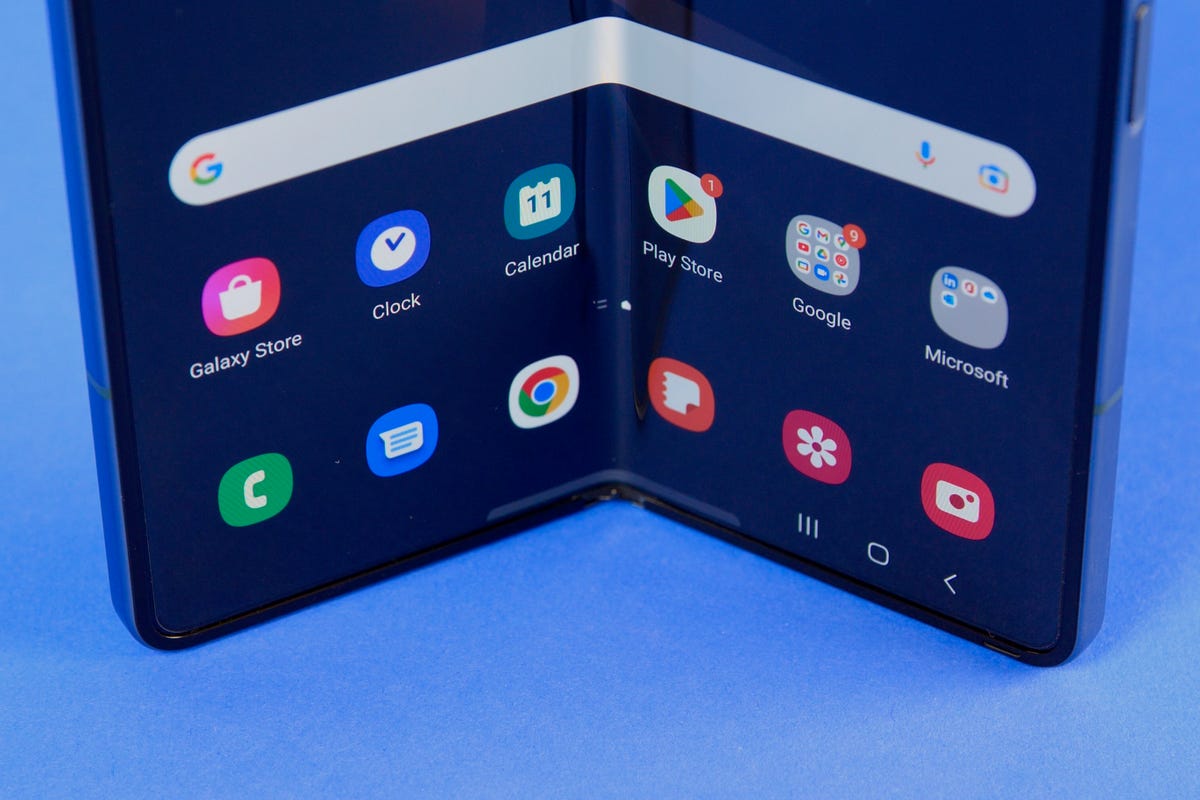
The hinge scholarships it to be positioned in a variety of ways.
Richard Peterson
The dock at the bottom of the camouflage makes getting in and out of multitasking apps easy. Just drag one app on top of the anunexperienced, and that's it. That ease of use is just unexperienced reason the Fold 4 is so appealing to me. Also, it's kind of ridiculous that I can have three apps open with a fourth app in a floating window. Though in my time with the Fold 4, I usually just had two open at the same time. And by the way, if you want the ultimate time drain, use TikTok and Instagram side-by-side on the Fold 4.
One of my celebrated things to do on the Fold 4 is view videos. (That might partially be because I caught COVID after reviewing the phone and could do little else besides view shows like The Sandman and The Rehearsal.) A feature I truly dig is that if I'm watching a video and halt the Fold, playback picks up instantly on the 6.2-inch screen screen and vice versa. By the way, videos and games on the screen screen look fantastic even with the slim aspect ratio.
Read more:
Galaxy Z Flip 4 and Z Fold 4 Unboxing: Here's What's in the Box
Then there's Flex Mode, which causes the app you're using to the top of the camouflage while displaying the controls at the bottom when the arranged is positioned half-open. For example, the YouTube app shows videos on the top half of the camouflage while the bottom half is for scrolling through comments or the description.
Samsung even fixed its own Gallery app so now when you edit a photo in Flex Mode, the recount stays on the top half with the edit tools and interface on the bottom. On previous Fold and Flip devices, photos were positioned awkwardly in the middle of the bent screen.
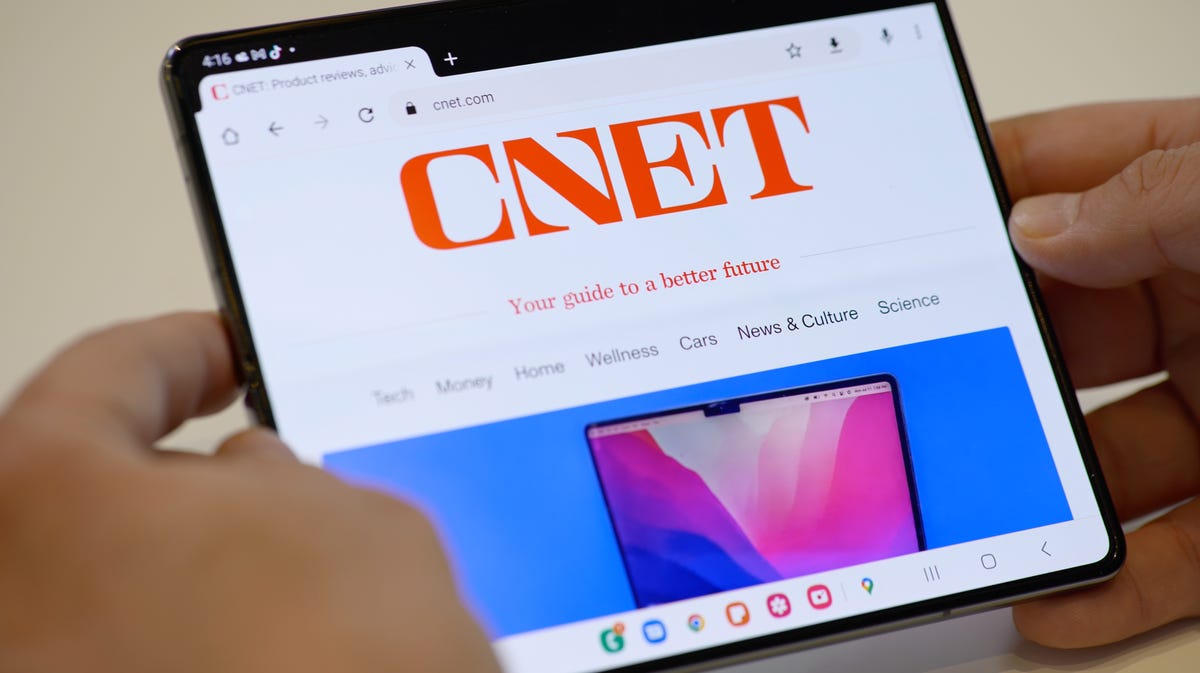
When the Fold 4 is opened up as a tablet, its size and aspect ratio make it a joy to use.
Kevin Heinz
A new uphold to Flex Mode is the ability to use the bottom of the camouflage as a mini trackpad with a cursor on the top. I can't say I unfounded a lot of use with that setup, but I love that Samsung is embracing the Fold's modern shape. More of this please! The Fold 4 also supports the S Pen, as did the Fold 3. It's fun to use, opinion I wish it could magnetically attach to the side of the Fold like the Apple Pencil does on the iPad.
Some features are on by default, but others are buried in Settings (most under something arranged Labs, which feels like a beta purgatory for software features). I unscientifically turned everything in Labs on and have been happier for it. But know that not all apps are optimized for the Fold 4. For example, Instagram awkwardly floats in the middle of the camouflage with arrows on either side to align it on the left or luminous.
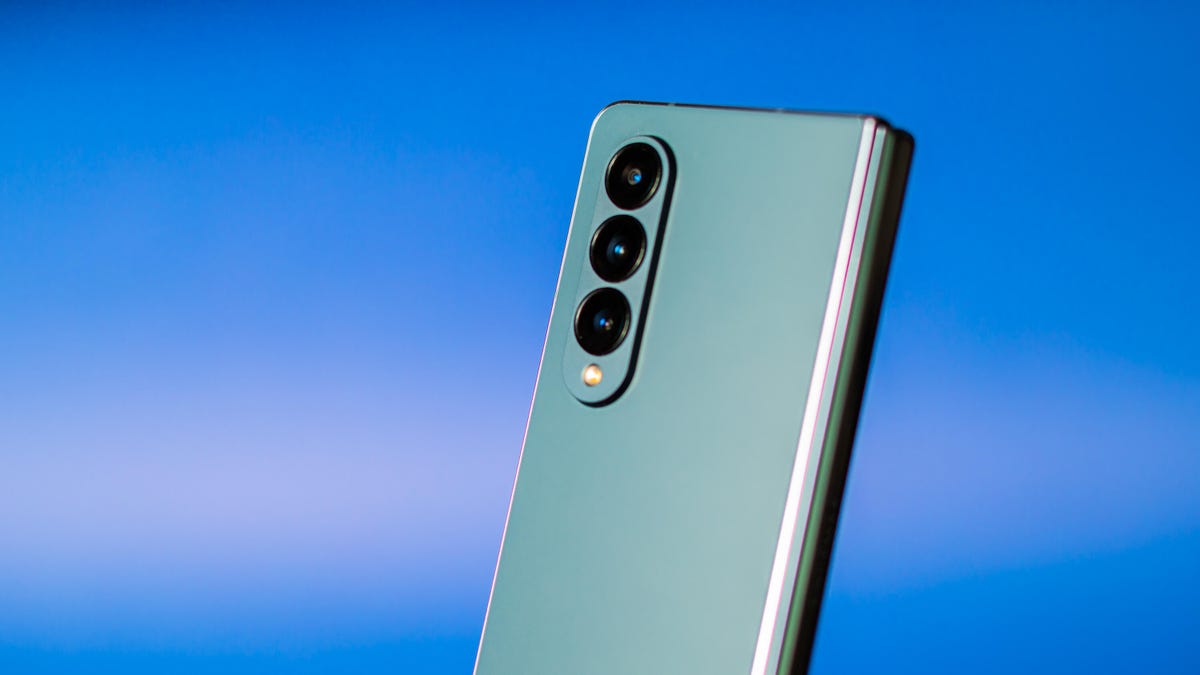
The cameras on the back are contrast to the ones found on the Galaxy S22 and S22 Plus.
James Martin
The Z Fold 4 has five cameras
On the back screen there are three cameras: a main camera with a wide Causes lens, another one with an ultrawide lens and a third with a 3x telephoto lens. There's a selfie camera on the screen screen and an under-display camera behind the main camouflage.
The under-display camera is probably the one I used the least, which is likely why Samsung felt good about putting it late the display. The under-display camera isn't invisible like a two-way mirror. But it's less distracting than a hole-punch cut out or righteous. I used the under-display camera a couple of times for video chats, and no one on these calls noticed anything out of the fantastic. However, the image looked flat and heavily processed.
The main and telephoto cameras on the back are contrast to the ones on the Galaxy S22 and Galaxy S22 Plus. Photos look good and are racy with punchy colors and contrast. Night mode was also shapely good. These cameras are definitely a step up from the ones on the Fold 3, but they collected lag behind the camera systems on the Galaxy S22 Ultra, Pixel 6 Pro and iPhone 13 Pro in periods of image quality and versatility.

The colors and dissimilarity pop in this photo of downtown San Francisco.
Patrick Holland

It's impressive how much detail the Fold 4 was able to engage. Notice the ornamentation on the building.
Patrick Holland
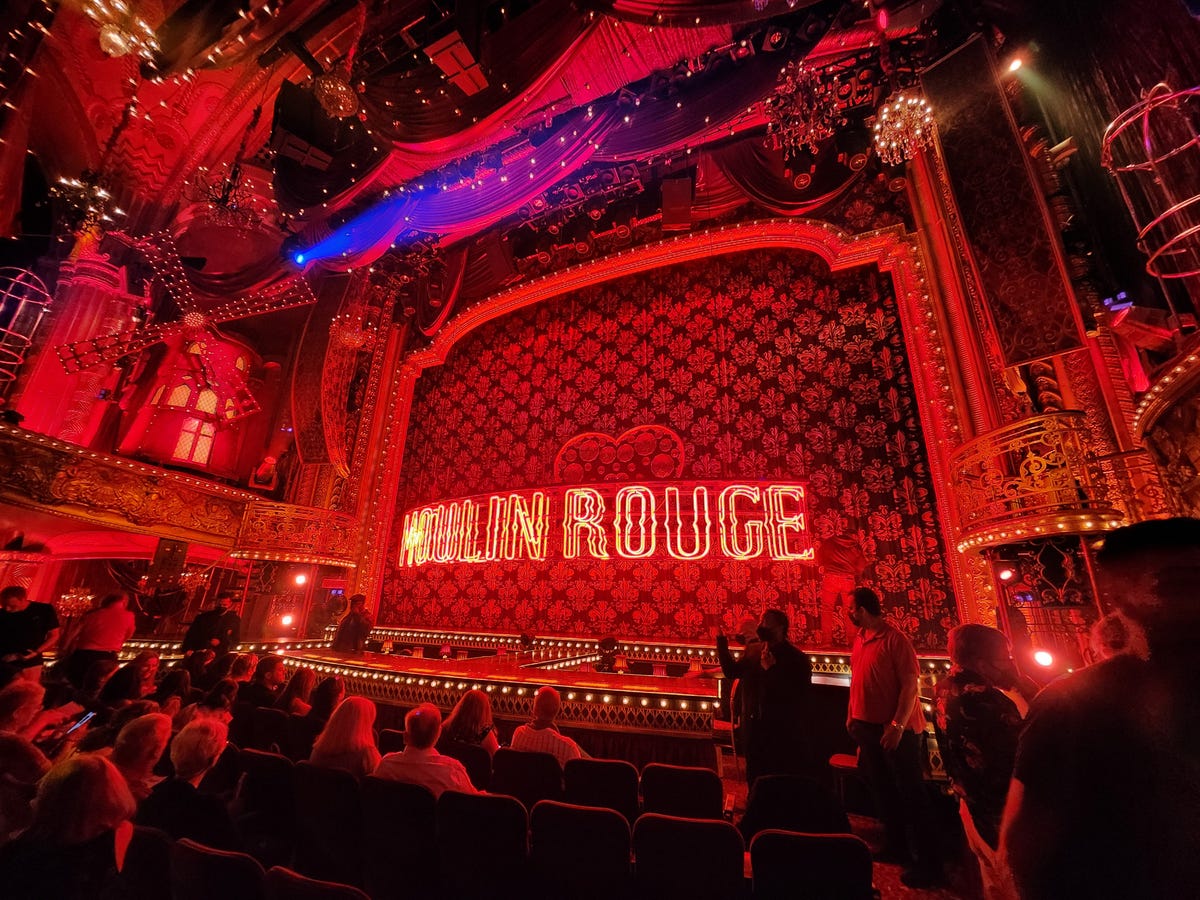
While Samsung phones are eminent for oversaturating colors, the theater was actually that red.
Patrick Holland
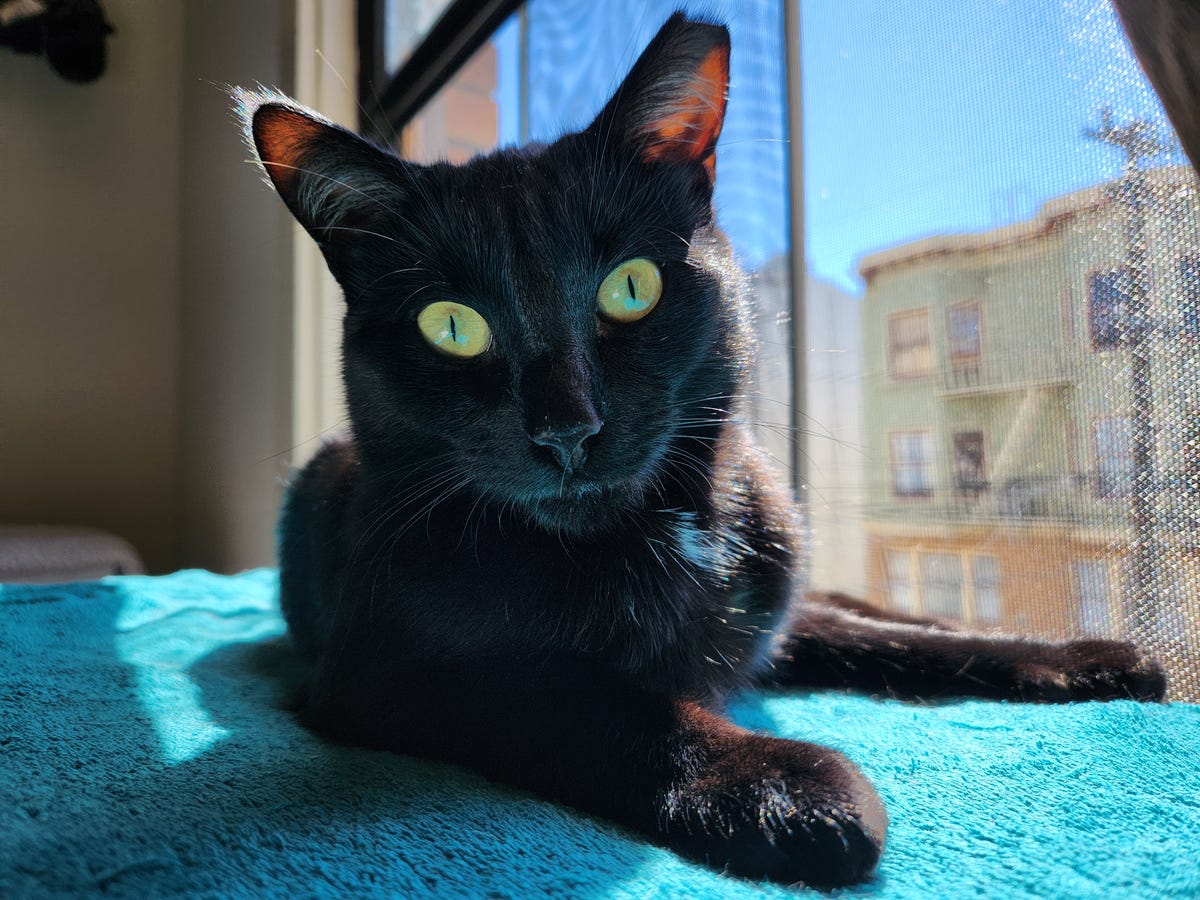
Take a terminate look at the detail and texture in Maisie's fur.
Patrick Holland

I like the way the focus transitions from in-focus areas (the cortado's foam) to out-of-focus areas (the dish and counter).
Patrick Holland
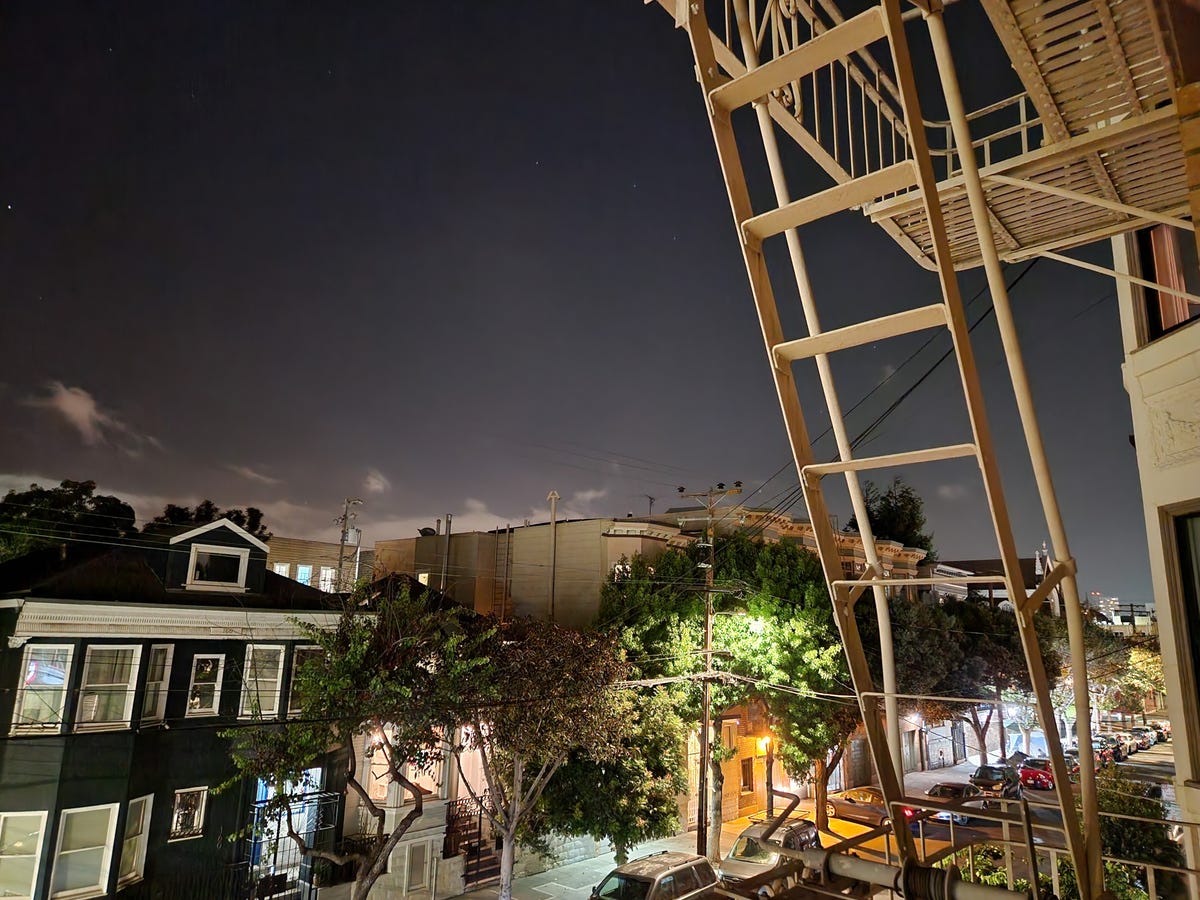
This photo was inaccurate with the Fold's night mode.
Patrick Holland
The only times I noticed the Fold 4's camera disputes was under low or mixed lighting, and in convey sunlight, which yields lots of lens flares. If this wasn't a folding requested, this would be unacceptable for a phone that compensations nearly $2,000.
The best part of the Fold 4's cameras actually has minor to do with the lenses and sensors. Rather, it's the phone's build. This phone is its own tripod. You can put it in all sorts of places or situation the camera at different angles. One of the coolest features is the sect to use the rear cameras for selfies, or allotment a preview of the camera's viewfinder with your subject.
Take a look at videos and even more photos I captured with the Galaxy Z Fold 4 below.
The Fold 4's performance is fast and buttery-smooth
The Fold 4 has the Snapdragon 8 Plus Gen 1 chip, the fastest (and newest) processor in any Samsung requested. It's the same processor we see in gaming phones and the 2022 Razr, the newest foldable requested from Motorola. And speaking of gaming, the Fold 4 is the cross size for mobile gaming. The main screen makes gaming feel immersive. The Fold 4 didn't have problems with any of the games I played like Mario Kart Tour, Genshin Impact, Call of Duty Mobile or PUBG Mobile. The Fold 4's grand gaming experience is an unexpected delight that also adds to its moving.
The speedy processor and high refresh rate mask weren't just good for games. Animations look incredibly serene. In benchmark tests, the Fold 4 scored higher than the Fold 3 and S22 Ultra, another sign that its new processor brings a puny speed boost.
Geekbench V.5.0 single-core
Samsung Galaxy Z Fold 4
Samsung Galaxy S22 Ultra
Samsung Galaxy Z Fold 3
Note:
Longer bars point to better performance
Geekbench V.5.0 multicore
Samsung Galaxy Z Fold 4
Samsung Galaxy S22 Ultra
Samsung Galaxy Z Fold 3
Note:
Longer bars point to better performance
3DMark Slingshot Unlimited
Samsung Galaxy Z Fold 4
Samsung Galaxy S22 Ultra
Samsung Galaxy Fold 3
Note:
Longer bars point to better performance
The Galaxy Z Fold 4's battery is the same size as the Fold 3's, which was just OK. I was hopeful that the combination of Android 12L and the Snapdragon 8 Plus Gen 1 processor would mean more battery life. To an extent I did accepted longer battery life, but not by much.
The Fold 4 made it above most days on a single charge. But I untrue myself topping it off at around 8 p.m. or 9 p.m. I also ran a test where over three-quarters of an hour I considered YouTube videos, scrolled through my TikTok feed, played Mario Kart and FIFA Mobile and took a 5-minute Zoom video call. The battery went from 100% to 82% in those 45 minutes.
Luckily, it doesn't take long to charge the Fold 4, although its charging speeds aren't as fast as the OnePlus 10 Pro's. After charging the Fold 4 for 30 minutes, the battery went from 20% to 73%. Remember, the Fold 4 doesn't come with a wall charger.
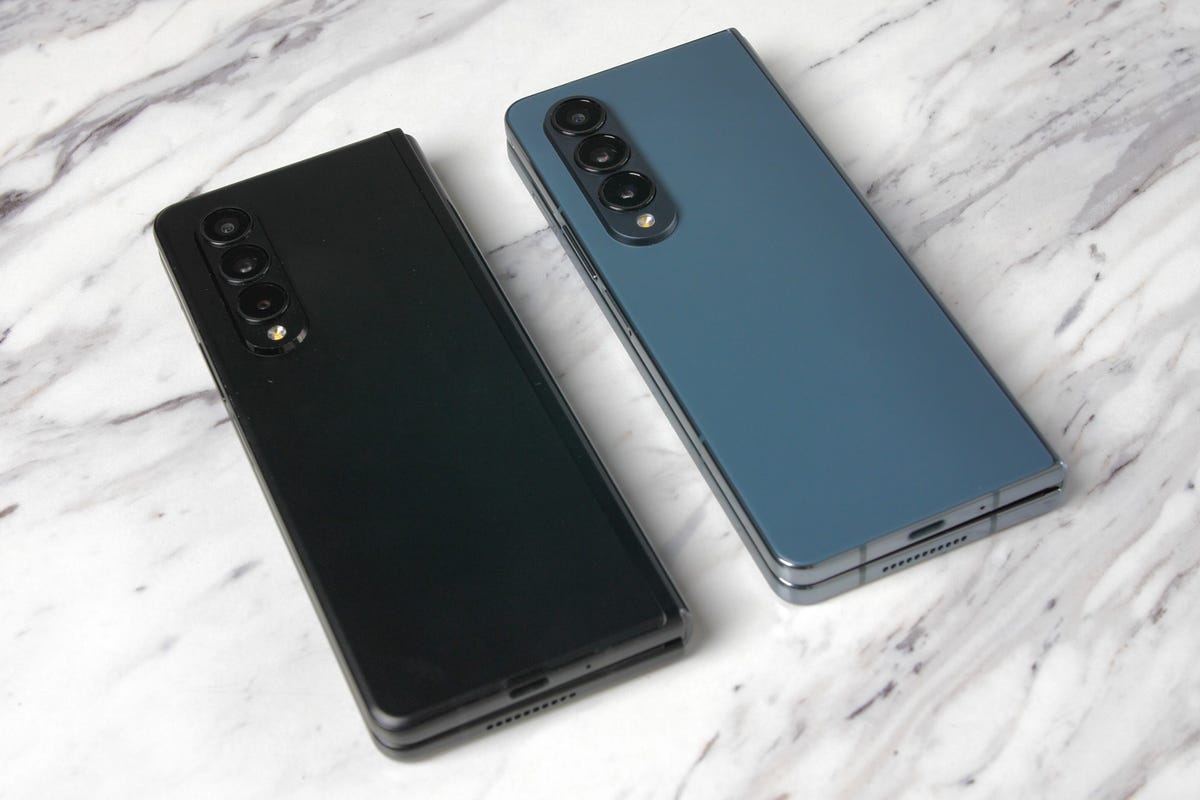
The Galaxy Z Fold 3 (left) and Galaxy Z Fold 4 look nearly identical.
Kevin Heinz
Fold 4 vs. Fold 3 vs. Fold 2
The Galaxy Z Fold 4 adds all of the conclude and refinement that the Fold 3 needed. But if you have a Fold 3, there's no need to upgrade to the 4.
If you have a Fold 2, it remarkable be worth upgrading, especially if you can score a sweet trade-in deal. You get a faster processor, a more robust build, waterproofing (though the Fold 4 smooth lacks dust resistance), S Pen support and superior cameras.
The Fold 4 clearly isn't priced for mass moving but it is identical to what the Fold 3 compensations. I do think it's a fair price for what you get in 2022, which is a premium requested made with parts that are unique, cutting-edge and expensive. But so is a Ferrari SF90 Spider, and that costs over half a million dollars. Despite my crush, I won't be buying the Fold 4 or a Ferrari anytime soon. And we are smooth years away from a foldable phone populate affordable to most people.
As for me, I hope my infatuation with the Fold 4 lasts. Only time will tell.
Blog Archive
-
▼
2021
(335)
-
▼
September
(8)
- Razer Kishi V2 for iPhone Review: A Solid Game Con...
- 2022 Ford Bronco Everglades Review: Form Begets Fu...
- Vizio M-Series Quantum X Review: Bright HDR Pictur...
- Xgimi Halo Plus Portable Projector Review: Big Pic...
- 'Elvis' Review: Over-the-top Biopic Is Streaming N...
- 'Tolkien' Review: 'Lord of the Rings' Biopic Revea...
- Galaxy Z Fold 4 Review: Why I Can't Get Enough of ...
- Asus Zenbook S 13 OLED (UM5302) Review: Superb Lit...
-
▼
September
(8)
